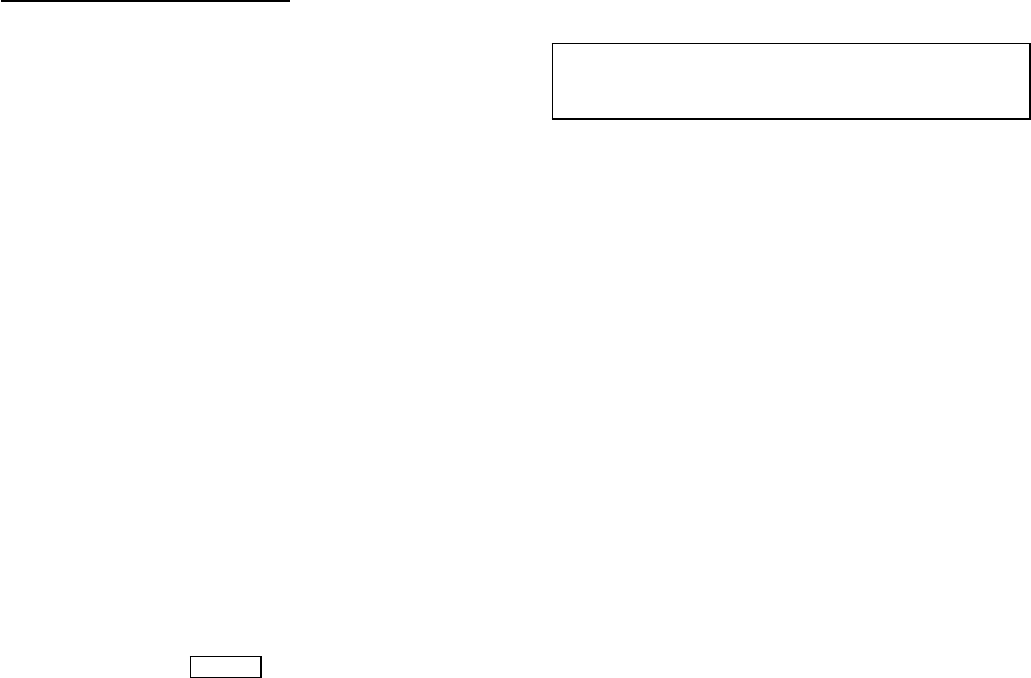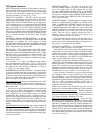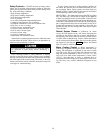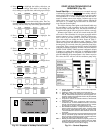
4. Lead chiller temperature pulldown rate of the CHILLED
WATER temperature is less than 0.5° F (0.27° C) per
minute.
5. The lag chiller status indicates it is in CCN mode and is
not faulted. If the current lag chiller is in an alarm con-
dition, then the standby chiller becomes the active lag chiller,
if it is configured and available.
6. The configured LAG START TIMER entry has elapsed.
The LAG START TIMER shall be started when the lead
chiller ramp loading is completed.TheLAG START TIMER
entry is accessed by selecting Lead/Lag from the Equip-
ment Configuration table of the Service menu.
When all of the above requirements have been met, the
lag chiller is forced to a START mode. The PIC control then
monitors the lag chiller for a successful start. If the lag chiller
fails to start, the standby chiller, if configured, is started.
Lag Chiller Shutdown Requirements — The following con-
ditions must be met in order for the lag chiller to be stopped.
1. Lead chiller COMPRESSOR MOTOR LOAD value is less
than the lead chiller percent capacity plus 15%.
NOTE: Lead chiller percent capacity = 100 – LAG PER-
CENT CAPACITY
The LAG PERCENT CAPACITY value is configured on
the Lead/Lag Configuration screen.
2. The lead chiller chilled water temperature is less than
the CONTROL POINT plus
1
⁄
2
of the WATER/BRINE
DEADBAND.
3. The configured LAG STOP TIMER entry has elapsed.
The LAG STOP TIMER is started when the CHILLED
WATER TEMPERATURE is less than the CHILLED
WATER CONTROL POINT plus
1
⁄
2
of the WATER/
BRINE DEADBAND and the lead chiller COMPRESSOR
MOTOR LOAD is less than the lead chiller percent
capacity plus 15%. The timer is ignored if the chilled
water temperature reaches 3° F (1.67° C) below theCON-
TROL POINT and the lead chiller COMPRESSOR
MOTOR LOAD value is less than the lead chiller percent
capacity plus 15%.
FAULTED CHILLER OPERATION — If the lead chiller
shuts down on an alarm (*) condition, it stops communica-
tion to the lag and standby chillers. After 30 seconds, the lag
chiller will now become the acting lead chiller and will start
and stop the standby chiller, if necessary.
If the lag chiller faults when the lead chiller is also faulted,
the standby chiller reverts to a stand-alone CCN mode of
operation.
If the lead chiller is in an alarm (*) condition (as shown
on the LID panel), the RESET
softkey is pressed to clear
the alarm, and the chiller is placed in the CCN mode, the
lead chiller will now communicate and monitor the RUN
STATUS of the lag and standby chillers. If both the lag and
standby chillers are running, the lead chiller will not attempt
to start and will not assume the role of lead chiller until
either the lag or standby chiller shuts down. If only one chiller
is running, the lead chiller will wait for a start request from
the operating chiller. When the configured lead chiller starts,
it assumes its role as lead chiller.
LOAD BALANCING — When the LOAD BALANCE
OPTION is enabled, the lead chiller will set the ACTIVE
DEMAND LIMIT in the lag chiller to the lead chiller’sCOM-
PRESSOR MOTOR LOAD value. This value has limits of
40% to 100%. When setting the lag chiller ACTIVE
DEMAND LIMIT, the CONTROL POINT will be modi-
fied to a value of 3° F (1.67° C) less than the lead chiller’s
CONTROL POINT value. If the LOAD BALANCE OPTION
is disabled, the ACTIVE DEMAND LIMIT and the CON-
TROL POINT are forced to the same value as the lead
chiller.
AUTO. RESTART AFTER POWER FAILURE — When
an auto. restart condition occurs, each chiller may have a
delay added to the start-up sequence, depending on its lead/
lag configuration. The lead chiller does not have a delay. The
lag chiller has a 45-second delay. The standby chiller has a
90-second delay. The delay time is added after the chiller
water flow verification.The PIC controls ensure that the guide
vanes are closed.After the guide vane position is confirmed,
the delay for lag and standby chiller occurs prior to ener-
gizing the oil pump. The normal start-up sequence then
continues. The auto. restart delay sequence occurs whether
the chiller is in CCN or LOCAL mode and is intended to
stagger the compressor motors from being energized simul-
taneously. This will help reduce the inrush demands on the
building power system.
Ice Build Control
IMPORTANT: The Ice Build control option is only avail-
able on chillers with PSIO Software Version 09 and
higher.
Ice build control automatically sets the chilled WATER/
BRINE CONTROL POINT of the chiller to a temperature
where an ice building operation for thermal storage can be
accomplished.
The PIC can be configured for ice build operation. Con-
figuration of ice build control is accomplished through
entries in the Config table, Ice Build Setpoint table, and the
Ice Build Time Schedule table. Figures 16 and 17 show how
to access each entry.
The Ice Build Time Schedule defines the period during
which ice build is active if the ice build option is
ENABLED. If the Ice Build Time Schedule overlaps other
schedules defining time, then the Ice Build Time Schedule
shall take priority. During the ice build period, the WATER/
BRINE CONTROL POINTis set to the ICE BUILD SET POINT
for temperature control. The ICE BUILD RECYCLE
OPTION and ICE BUILD TERMINATION entries from a
screen in the Config (configuration) table provide options
for chiller recycle and termination of ice build cycle, respec-
tively. Termination of ice build can result from the ENTER-
ING CHILLED WATER/BRINE temperature being less than
the ICE BUILD SET POINT, opening of the REMOTE CON-
TACT inputs from an ice level indicator, or reaching the end
of the Ice Build Time Schedule.
ICE BUILD INITIATION — The Ice Build Time Schedule
provides the means for activating ice build. The ice build
time table is named OCCPC02S.
If the Ice Build Time Schedule is OCCUPIED and theICE
BUILD OPTION is ENABLED, then ice build is active and
the following events automatically take place (unless over-
ridden by a higher authority CCN device):
1. Force CHILLER START/STOP to START.
2. Force WATER/BRINE CONTROLPOINT to the ICE BUILD
SET POINT.
3. Remove any force(Auto) on theACTIVE DEMAND LIMIT.
NOTE: Items 1-3 (shown above) shall not occur if the chiller
is configured and operating as a lag or standby chiller for
lead/lag and is actively controlled by a lead chiller. The lead
chiller communicates the ICE BUILD SET POINT, desired
CHILLER START/STOP state, and ACTIVE DEMAND LIMIT
to the lag or standby chiller as required for ice build, if con-
figured to do so.
36


















